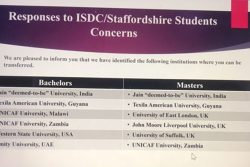MUMBAI, (Reuters) – For a show it was hard to beat: A DJ blasted Bollywood songs, fans decked out in the colours of the home side danced in the aisles, and the wife of the billionaire team owner perched on an electric-blue sofa near the Mumbai Indians’ dugout.
But just as local hero Sachin Tendulkar struggled with his cricket on the field, India’s glamour-packed cricket league is having difficulty sustaining momentum four years after it burst forth with a TV-friendly format, cheerleaders and big salaries.
A series of scandals has tarnished the league’s image, teams are losing money as player costs escalate, TV ratings are down, and franchise owners are still figuring out how to make the most of their investments from a season lasting less than two months.
“We haven’t broken even yet. We’re hoping we’ll get there this year, but the last three years have been difficult for us,” said Arvinder Singh, chief operating officer of the Kings XI Punjab, a team co-owned by Bollywood actress Preity Zinta.
“Sports franchises in the EPL and NBA build a year-round connect with their fans. Also, merchandising is a huge part of their business, but in India, it’s yet to take off,” Singh said.
An April study by UK-based Brand Finance figures the IPL brand is worth $3.67 billion, a drop of 11 percent from a year ago but still above an estimated $2 billion in 2009.
Average TV ratings for the first 49 matches of the season were down more than 25 percent from the same point last year to their lowest level in the IPL’s four-year history, according to viewership analysis firm TAM Sports.
That may be the result of cricket fatigue following India’s World Cup win on home soil, but it’s bad news for teams looking to build year-round buzz, as well as for ad sales for next year.
At the same time, player salaries are up 40-45 percent from last year, a report by Kotak Institutional Equities found.
The cost of franchises has soared. Two teams paid a combined $703 million to begin play this season — far more than the roughly $90 million paid on average by the eight original sides.
IPL teams face the challenge of building brands and loyalty among fans obsessed with the national side and its stars, to the extent that opposing fans often root for the likes of Tendulkar and India captain Mahendra Singh Dhoni against their own team.
“I’ve come because I want to see Sachin Tendulkar batting. If he wasn’t here, I wouldn’t have come all the way,” said Vaishali Ranadive, who was wearing a Tendulkar t-shirt and drove 180 kilometers from Nashik with her husband and two children to see the Mumbai Indians and their hometown star.
REVOLUTIONARY AND EXILE
Under the leadership of former chairman Lalit Modi, the IPL revolutionised the game as “cricketainment”, with its short Twenty20 format, player auctions, post-game parties and heavy advertising, dazzling fans and offending purists.
Celebrity owners are part of the show and include Mukesh Ambani, India’s richest man, as well as spirits and airline magnate Vijay Mallya and Bollywood superstar Shah Rukh Khan.
The IPL’s rise underscored the emergence of a brash, youthful India as a player on the global stage. At the same time it became symptomatic of a darker side of India and the confluence of money and politics, erupting in scandal last year.
Hailed as a gamechanger who helped make India the centre of the global cricket economy, Modi was accused of mismanagement and ousted from his position last year by the Board of Control for Cricket in India (BCCI), which owns the league.
Shashi Tharoor, an author who was one of India’s highest-profile officials, was forced to resign as a junior minister last year after Modi accused him of using political muscle to influence team bids.
Now based in London, Modi was unwilling to return to India because he feared for his life, his lawyer was quoted as saying in October. Accused of financial irregularities, Modi has denied any wrongdoing.
A chaotic offseason saw the BCCI terminate the contracts of two teams — Kings XI Punjab and Rajasthan Royals over ownership questions — only to see them win reprieves by court order.
LOCATION, STAR POWER
IPL Chief Executive Sundar Raman said some teams are run better than others, and that factors including location and the stature of a team’s stars help determine success.
“If you have a Sachin Tendulkar in your team, or if Shah Rukh Khan owns your team, you will expect a larger following or a greater appeal,” Raman told Reuters.
Part of the challenge is having access to those star players beyond the short season. Top three finishers compete in the Champions League later in the year, but teams have limited claim on players with heavy commitments in a crowded calendar.
“The difficulty is that this is a six-week tournament but we have to keep our brand alive for the rest of the year,” said Amrit Mathur, chief executive of the Delhi Daredevils.
“At some point we have to have a conversation with the BCCI on availability of players and the kind of activities we can do all year around,” he said.
The movement of several star players in the league auction alienated some fans. World Cup hero Yuvraj Singh, a native of the northern state of Punjab, was not retained by his home team and now captains first timers Pune Warriors.
“The novelty has worn off, and there is sameness to the games,” said cricket writer Pradeep Magazine, a consulting sports editor with The Hindustan Times.
CLUB VS COUNTRY
The World Cup ended a week before the IPL season began, and India heads for a tour of the West Indies days after the season finishes, meaning franchises are not just competing for access to players, but also for advertisers.
Japan’s Yamaha Motor Co , a first-time advertiser this year through its sponsorship of the Hyderabad-based Deccan Chargers, has not yet decided whether it will be back next year.
“It all depends. There are many (India) series in between this and next year’s IPL and we will have to re-evaluate and see which is better — IPL or maybe a series,” Roy Kurian , who heads Yamaha’s business in India, told Reuters.
“When you have country matches, like India versus Australia or Sri Lanka, obviously, people will watch those more than a local IPL match,” he said.
The 10 teams earn revenue from broadcasting rights, IPL sponsorships, team sponsorships, merchandise and gate receipts.
That may not be enough in a short, tightly-packed season.
Indiawin Sports, the subsidiary of Ambani’s Reliance Industries that owns the Mumbai Indians, seen as one of the best-run teams, lost 154 million rupees ($3.4 million) on sales of 1.13 billion rupees in the financial year that ended in March, the conglomerate’s annual report said.
According to Brand Finance, the Mumbai Indians — which retained its core stars from its previous three seasons — Chennai Super Kings, and Mallya’s Royal Challengers Bangalore have done best at building their brands.
On a recent night in Mumbai, the loyalties of the home crowd appeared to be diluted — for better or worse.
“Nothing, absolutely nothing can compare to the high we got when India won the World Cup — not even if Mumbai Indians win the IPL,” said Mahesh Shinde, who along with his wife and 14 friends wore t-shirts that spelled out Sachin Tendulkar.








